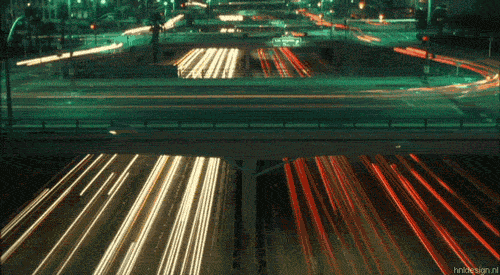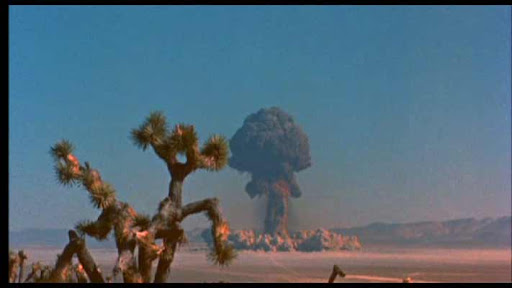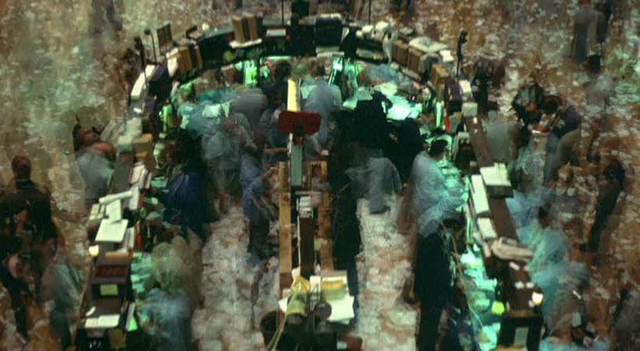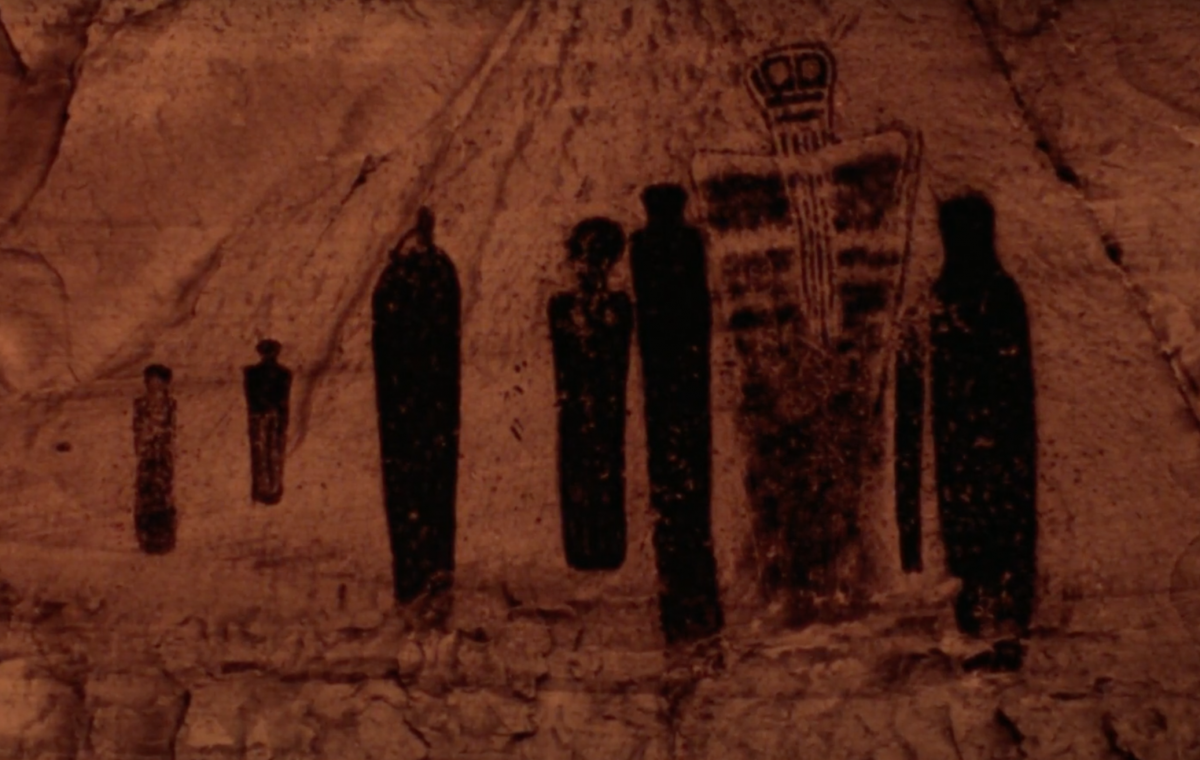One trend evident at this year’s Indie Memphis was a move toward “slow cinema.” Films like Drive My Car, Memoria, and I Was a Simple Man all take their time getting where they’re going, sacrificing plot momentum for long moments of contemplative imagery.
Memphis filmmaker Joshua Cannon, who won the Hometowner Music Video Audience Award for his video with Don Lifted, is a fan of the low and slow. We recently sat down to take slow cinema to the extreme with director Godfrey Reggio’s 1982 experimental masterpiece, Koyaanisqatsi.
Chris McCoy: Okay, Joshua Cannon, what do you know about Koyaanisqatsi?
Joshua Cannon: I only know one thing. I was really curious to see what the title translated to, but I didn’t want to know anything about what I was getting into. I wanted to have a blind experience. So I just looked up the title translation and saw a few things. I’m going to butcher this, but it translated to something like “a life that spurs a new way of living out of the life that we’re currently in.” And that got me fascinated.
CM: It literally translates as “A life out of balance.” We were talking at Indie Memphis about slow cinema, and you talked about loving Terrence Malick, and wanting to do something long and immersive.
JC: Maybe it was over the pandemic, because prior to that, I felt like my life was just moving at such a fast pace. I was just like many of us, constantly going, and then something unexpectedly came up. Once I had more time on my hands just to take things, and to dive into movies as a way to just not confront everything going on, I stumbled into a lot of slow cinema. Tsai Ming-liang’s Rebels of a Neon God and those films. I fell in love with that kind of movie-making. I think it just reflected where I was. There’s something about a lot of dialogue-less moments bumped against each other, and it becomes such an individualistic thing, I guess. Every time I have a conversation with friends about a movie, we just get totally different experiences out of it. Tsai Ming-liang’s newest movie, Days, was wild. It’s got long takes, unbroken. And you start from watching a movie to experiencing what you’re watching, and it changes. You just sit with this unbroken thing. I just got fascinated by it and kept diving down that wormhole.
CM: I said, “You should watch Koyaanisqatsi.” And you were like, “What the hell is that?” I was like, “Okay, this is perfect.” Because the first time I watched this movie was in a film class with a teacher who told us nothing. Nobody in class knew what we were going to do. He was just like, “Here it is!” I wanted you to have the same experience.
86 minutes later …
CM: You are now a person who has seen Koyaanisqatsi. What did you think?
JC: Thank you for sharing that with me. That was pretty great. I’ve honestly never seen anything like it, but it didn’t feel like it’s the type of movie that you can quantify as like, oh, that was a great movie. It’s hard to have an opinion about that movie, because it’s such a singular experience.
CM: There’s no dialogue until the closing credits. There’s no human voices except singing. It’s all pure montage. It was Godfrey Reggio and the cinematographer [Ron Fricke], and four credited camera assistants. There were more people credited as Hopi prophecy consultants than there were on the camera crew. They were just traveling all over the world, filming stuff, and they had an environmental vision. Eventually, they got some money from Francis Ford Coppola and what was left of American Zoetrope. There had never been anything like it. Nobody had ever done 70 millimeter time-lapse outdoors like that before. You see the visual children of Koyannisqatsi everywhere now.

JC: It’s just insane to imagine what it would have been like having that experience as someone in a theater for the first time when it came out. I feel like not knowing what it was really added to the experience. I thought it would be grounded in something environmental, but I fully walked into your house expecting to see a film that was more straightforward. I didn’t expect to not hear a human speak for 90 minutes.
CM: It felt very quick to me this time. I was just engrossed in the images. You said something while we were watching it, like about halfway through, things just become very abstracted.
JC: It becomes full texture in a way. What was so wonderful about seeing it for the first time is at first, you’re not really sure if it’s just like an introduction. You don’t really know what’s going on. And then as it keeps folding into itself …
CM: You’re like, “This intro’s been going on for 30 minutes now.”
JC: Where are you taking me? But then, once you give yourself over to it and stop trying to piece anything together, it becomes a very pure experience. The images that they choose to juxtapose against one another start just kind of like folding in on top of one another, and it gets inside of you, in a way. It gets under the hood.
CM: It’s described as non-narrative, but I feel like there’s a narrative, there’s a story. Here’s the natural world. Here’s the coming of humans, disrupting the natural world, the break from nature. Here is this society that we’ve built. Especially in the city parts, there’s a very documentary-like aspect to it. This is what the world looks like right now. And then, it’s a warning: We can’t keep this up.
JC: It’s an artifact now, watching that with all that we’re currently experiencing and all.
CM: Reggio was right. It was perfect. It was prophetic. Yes, it’s based around a Hopi prophecy — and it actually was prophetic.
JC: Because there’s no dialogue, there’s no one guiding you forward with this, you’re experiencing images against the score. Even though there’s kind of like a universal message that we can get from it. Everyone comes away with a really unique experience. We subscribe what we already think about the image that we’re seeing on to them. So our perspective really shapes how we sit with this movie.
CM: Yeah. It’s not demanding of you. I think that helps you sort of step back. So when you get to the end, his conclusions seem natural, like you’ve figured them out for yourself, because it allows you to step back from life, and to get some kind of perspective on it.
JC: It’s like a meditation.
CM: Yes! It’s a meditation! But if you sort of give yourself over to it, he induces awe about the world — the natural world, the built world, all of it. By the time we’re in the Oscar Meyer making hot dogs, you’re like, “look at this, it’s awesome!”
JC: We start with these beautiful vistas of the natural world …
CM: Monument Valley never looked better.
JC: Places that are just absolutely stunning. And then we hard cut into this giant truck.
CM: It’s belching this big cloud of black smoke, and you’re like “Oh, this is not good.”
JC: We just keep taking it for granted. We keep building more and more and then knocking things down. You see like the windows broken out. You see the way that we don’t know when we’ve had enough. We just keep going and keep going and keep going. Look at the other side of humanity’s crazy innovations through the 20th century. They made decisions that had long-term ramifications. When you see all those cars, you’re like, we’re paying the price for all that innovation.
CM: There’s that shot where the lines of cars are wheeling around in the frame, then it cuts to lines of tanks. When the atomic test footage came along, I heard you say “wow” out loud.

JC: I had a lot of visceral reactions in a way that I haven’t had when seeing a movie in quite a moment. When you see that bomb, if you’re just looking at shapes on the screen against the music, it’s kind of beautiful, as awful as that is to say. Then you realize the context of what you’re looking at. It’s absolutely heartbreaking — like, the world doesn’t go back from here.
CM: Even when it’s planes dropping napalm, I’m looking at it, thinking, “This footage is gorgeous.” Like you were saying, it’s an emotional ping pong, going back and forth between. “Wow, this is beautiful,” and “Oh my God, that’s an atomic bomb.”
JC: It feels like the director is allowing you to sit with it and come to your own determinations and emotional experiences.
CM: What’s your emotional experience?
JC: Maybe it is my bias, but I think it leans toward saying: Look at what’s going on, the evolution of it all, how long you’ve been here, and see we’re not doing something right. You can judge all that for yourself. We’re not going to lead you to a conclusion, you know? There’s so many beautiful moments in it, but toward the end where there was that shot … I didn’t even know what was going on for a moment, where all those people are in a room and they overlay time lapse, and they look like ghosts.

CM: It’s in the New York Stock Exchange. I think it was multiple exposures of the same film, done live. Everything that was stationary was sharp and everything was moving around were like ghosts. There were a number of layers, and it looked like one layer, they ran the film backwards. because there were ghost people walking backwards. I’ll bet you it was done in-camera.
JC: That’s so tricky, so amazing they pulled that off. It looks beautiful. You get to that point where we’re almost kind of at the crescendo, and everything’s building. You see the impermanence of everything up to this point. We were here, and as soon as we built it, it’s gone. But the land is still gonna be here.
CM: It’s cyclical. The petroglyphs at the beginning, the cave art, are echoed first in the power transmission towers. Then they’re mirrored again in the skyscraper imagery. And then it comes back at the end and you’re like, “Oh man, we’ve been looking at the same visual motif over and over again.”
JC: It was pretty brilliant how they brought it all back together at the end. I love what you said about those towers, that they are marching across the landscape like soldiers.
CM: And it’s such a simple shot, it’s just a slow pan down the power lines.
JC: That’s so much of what I love about the way that they chose to shoot it. We have a lot of really simple moments that are capturing impossibly vast things that overwhelm you. But it’s not flashy. A lot of it is just finding the best moment to highlight.
CM: Like the airport, with that single shot where the planes are going in and out and coming straight at the camera.
JC: I’d like to know how long that took.
[ed note: According to Wikipedia, cinematographer Fricke and a camera assistant filmed at the airport for two weeks. The 2 minute 30 second scene of airplanes taxiing is the longest unbroken shot in the film.]
CM: So, would you recommend Koyaanisqatsi?
JC: Definitely. Sam Leathers, if you read this far, I really hope you’ll watch this movie. It wasn’t a refreshing movie. It’s a really heavy movie, in a sense. But it was refreshing to see a movie like that, because I hadn’t really ever experienced anything like that before. You couldn’t have told me beforehand what it is, even if you’ve seen this or that scene, there’s nothing like watching it all together.
CM: I think about the Ed Wood quote, “I can make an entire movie out of stock footage!”
JC: You know, it takes a certain kind of dude to go, “I don’t know what we’re going to end up with, but the planet is so significant, I want to show how precious this thing we have is, and this is the way I’m going to communicate it.”
CM: I don’t feel like it’s anti-technology, especially because it is such a product of technology. It’s a product of a technological civilization that could make 70 millimeter cameras, giant zoom lenses, and computer-controlled exposures and stuff. It is an artifact of technology itself. It has a skeptical eye towards technology, but I don’t think it’s anti-.
JC: I don’t think it is, either. I think it’s about the agreement we have with the way that we use it. Are doing that appropriately? Are we being responsible with the decisions we’re making, with the abilities we’ve built, what we’re continue to build?
CM: These things we’ve made are beautiful. Even the stuff in the shopping mall is beautiful.
JC: This is another wormhole, but it’s like where we are now, in 2021, we look at the way the Earth is rapidly shifting. We look at the things that are happening now, the weather events we’re having, just like with droughts around the world. I am by no means an expert, but when you look at a film like this, you see how, as much as it’d be great for all of us to be able to make our small changes — there’s things we can do every day that can make a difference to the way we live to help create a more sustainable space. But you look at the corporations and businesses and the people who have engineered the world to exist a certain way, and so, while we can all play our part, there’s really a huge burden on us, the way that our livelihoods exist. And then it’s tough, because you have a lot of working class people who rely on what these corporations have built.
CM: So the corporations can build something else.
JC: It’s a choice. That’s what has to happen.
CM: That’s what’s so frustrating about climate change to me: It boils down to a bunch of old energy executives who can’t figure out how to make money another way. If you’re going to be Mr. Free Market Entrepreneur guy, then go figure out a way to make money where you’re not exploiting and destroying the ecosphere!
JC: There’s only so much that can be accomplished with working class and middle class people, and just people in general. It has to be done at a very large scale.
CM: There has to be systemic change. There’s no way to do it just from consumer choice. There has to be full-on, systemic change, and I’m not feeling real good about that right now.
JC: I would keep thinking about the title refrain, how it would come up every so often. Once you get to the end and read the translations from the Hopi, it’s a reminder that’s letting you know: Take this to heart. This is what’s unfolding. It doesn’t have to be this way, but there might not be any turning back if you don’t make a difference now.
